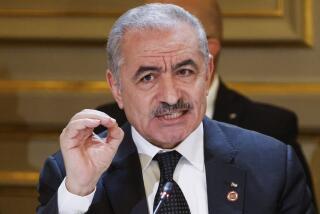Armenia Chief Who Backed Karabakh Pact Quits
- Share via
MOSCOW — Armenia’s president, Levon A. Ter-Petrosyan, resigned Tuesday after more than seven years as leader of the struggling Caucasus nation, a decision that signaled the defeat of efforts to settle a long-simmering regional conflict and avert another outbreak of bloodshed.
He was forced out after his most important political backers in the regime resigned or defected to vehement opponents of his decision in September to yield to international pressure for compromise to settle the 10-year-old battle with neighboring Azerbaijan over the ethnic enclave of Nagorno-Karabakh.
Ter-Petrosyan had reluctantly agreed to proposals from the Organization for Security and Cooperation in Europe to allow the return of some of the more than 500,000 Azerbaijani refugees from Karabakh and Azerbaijani territory surrounding the enclave that was seized by Karabakh Armenians during six years of fighting.
In a television speech to Armenia’s 3.6 million people, Ter-Petrosyan confirmed that he quit under pressure from opponents of his Karabakh policy and made it clear he considered their victory a setback for the prospects of peace.
“That I have decided to resign means that I found the alternative more dangerous for our state,” said Ter-Petrosyan, 52, who was first elected to head Armenia in August 1990, when it was still a Soviet republic.
Little official reaction to the resignation was forthcoming because it was announced late Tuesday. But analysts said they feared renewed conflict in Karabakh and possible threats to the lucrative oil deals involving Azerbaijan as it taps the Caspian Sea’s vast resources. The 4-year-old cease-fire had allowed international oil consortia to conclude that Azerbaijan was now stable enough to invest in.
“This is a very, very serious crisis with consequences that may get out of hand,” said Sergei A. Arutyunov, Caucasus department chief of the Russian Institute of Anthropology and Ethnology. “I cannot rule out the possibility that Azerbaijan may take advantage of this temporary chaos in Yerevan [the Armenian capital] and send its troops into Karabakh once again.”
Karabakh, a tiny, mountainous territory of 170,000, is predominantly populated by Armenians. But it is wholly surrounded by Azerbaijani territory, due to a 1921 gerrymandering of the region’s borders when the Caucasus territories were made part of the Soviet Union. Armed conflict between Christian Armenians and Muslim Azerbaijanis flared in 1988, as the Soviet Union was beginning to unravel; thousands died in ethnic fighting before a 1994 cease-fire.
Although open warfare stopped with the truce, tensions have remained high and outbreaks of violence frequent. Officials in the Azerbaijani capital, Baku, have been eager to settle the conflict so they can regain control of territory occupied outside Karabakh and resettle throngs of refugees.
Baku has insisted that Karabakh remain part of Azerbaijan, though with a high degree of autonomy. It was Ter-Petrosyan’s apparent concession to that condition and his acceptance of the return of Azerbaijani refugees to territory that was not originally part of the enclave that split his Cabinet and precipitated his downfall.
Parliament Speaker Babken Ararktsyan becomes acting head of state until new elections.
Times special correspondent Selina Williams in Tbilisi, Georgia, and Sergei L. Loiko of The Times’ Moscow Bureau contributed to this report.
More to Read
Sign up for Essential California
The most important California stories and recommendations in your inbox every morning.
You may occasionally receive promotional content from the Los Angeles Times.













